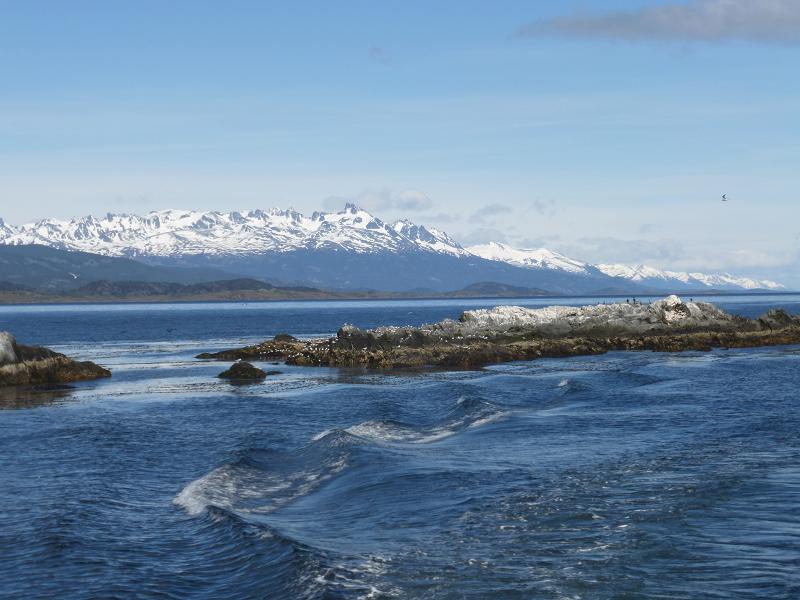
In late November 2014, Martin and Liz Fearn from Harberton (Devon) visited Estancia Harberton (in Tierra del Fuego, Argentina) and they wrote about their visit for the village email circulation and website:
"When one looks forward to something special and the expectation builds, it's often a disappointing anti-climax when the time comes. Definitely not in this case! When Tommy and Natalie Goodall came to Harberton from Tierra del Fuego (TdF) in 2003, we attended the talk Natalie gave at Tristford and the germ of an idea to visit the Estancia one day was planted. Now that I have finally retired, Liz and I decided to include it in our journey to Australia. It's only a slight diversion!
Ushuaia is just over three hours flying from Buenos Aires and is the southern-most city in the world. The term "Uttermost Part of the Earth" has been adopted latterly by the tourist industry in TdF, but was used by Lucas Bridges for his fascinating book published in 1947. These days it's mainly the jumping-off point for Antarctic cruises, but for us a springboard for an 85km hop eastwards along the Beagle Channel.
Beagle Channel looking west
The islet in the foreground is mainly a breeding ground for cormorants and the snow-capped mountains are on the Chilean side of the water.

We didn't know what to expect weather-wise but, in the event, although it was single-digit Celsius cold on the water, it was bright and sunny. The town of Ushuaia (population approx 58,000) is backed by mountains still snow-capped as it's still only spring here - the town is best viewed from the water as it pretty unsophisticated; really only a service town with a large Argentine Navy base at one end of the built-up area. The news agency in Montevideo reports say that in the last few days, the Argentine Congress has passed a law requiring all public transport to display banners "Las Malvinas son Argentinas". No hint of that on a personal basis here - everyone we've met in Argentina has greeted us with great friendliness with not the slightest hint of animosity. Also, cruises to/from the Antarctic are calling at the Falklands and South Georgia with no apparent problems. The only evidence of official displeasure was a small notice on the wharf about British illegal piracy since 1833 and a leaflet in the information centre, in English, giving a "reasoned" discussion as to why the islands should be Argentine.
So, to more important things! Ushuaia is here, largely because Thomas Bridges established the South American Missionary Society base here. He had learned the local (Yahgan) language from natives taken to the Society's station on Keppel Island (Falklands). When he turned up on Tdf shores, they were impressed that he spoke to them in their own language, which smoothed the way for him to be allowed to stay. Eventually he brought his wife Mary (nee Varder of Harberton) and first daughter, Mary, to live permanently in what he called Ooshwhya (from the local language, but now standardised as Ushuaia). Five more children followed and more settlers, including Argentine government officials in due course.
He gave up the church work in 1886 and was granted land by the Argentine government in recognition of his efforts to settle and subdue TdF. This was the 22,000 hectares which he named Estancia Harberton. Mary and the children didn't move there immediately, but waited while Thomas built basic living accommodation for the family.
Clearly, that was not going to be satisfactory, so the family came to England to get his father-in-law, Stephen Varder to build them a house. The Varder family were then living in what is now Simmons Farm in Harberton, so Stephen constructed the building, then disassembled it, numbering the parts. Wooden frame and walls, galvanised iron roof, glazed windows, furniture and fittings all made the voyage to TdF. More followed over the ensuing years from numerous sources, but the original house was from Harberton - and is still there, being used by Tommy Goodall (great-grandson of Thomas) and his American wife Natalie.
General view of Estancia
The main house in the distance – the only two storey building. To the left is the mouth of the inlet, Puerto Harberton, and Beagle Channel beyond.
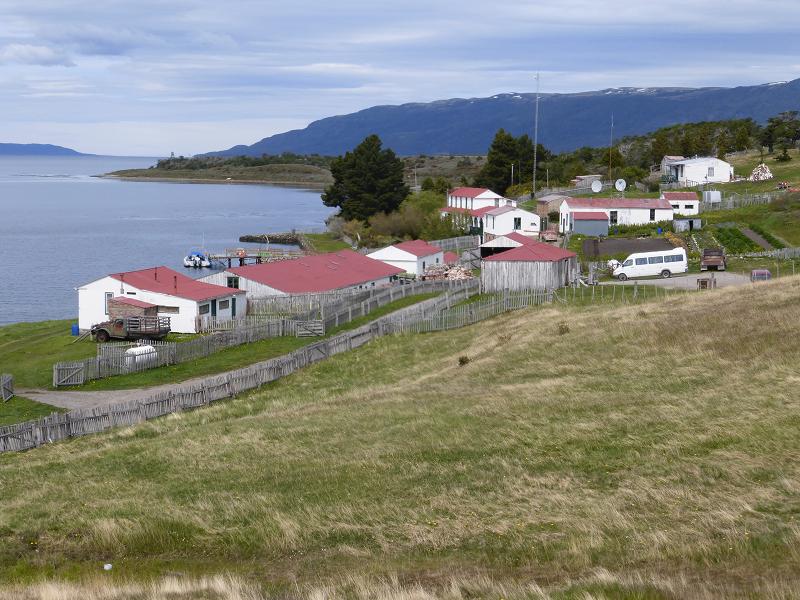
Tommy is the son of John Goodall who married Clara Bridges, daughter of Thomas' third son, Will.
By water, the estancia is reached by catamaran eastwards along the Beagle Channel which is the divide between Argentina and Chile, taking in spectacular views of some smooth, but many jagged peaks, and viewings of small islands colonised by sea lions, seals, cormorants and penguins. Then a sharp turn to port and into the sheltered inlet of Puerto Harberton and the settlement hoves into view.
Estancia Harberton is a popular destination for a day trip from Ushuaia, but few actually stay. It’s not difficult, as there is a two-room guest house, but we were the only guests. We were certainly treated royally and soon got the geography of the farm (as they call it) in our heads. The estancia has not been a working farm since 1996 when about 80% of their sheep froze to death. It was the final nail. Before that they had run up to 200,000 sheep and cattle over the property which was largely fenced and managed in the early days by Thomas’ sons - Lucas in the east and Will in the west and Despard looking after the homestead and managing the native labour force.
View of Estancia across the water
The farm settlement from the end of the peninsula on the western side of Puerto Harberton.
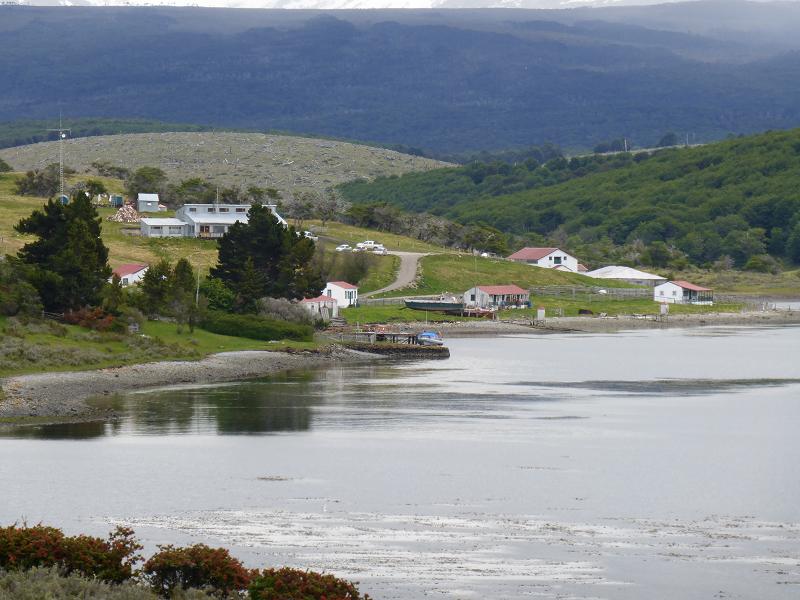
The waiting and guiding staff are all Argentinian, many using time at the farm as practical experience to support their formal college studies in tourism and leisure. All spoke English to a certain degree, often with charming pronunciation. Our particular guide was Juan (Juani to his friends) who is in his second season at Harberton - the season lasts from November to March or April, depending on the weather.
The main house is the oldest and most interesting part of the estate, but the family have updated the facilities with a tea house near the wharf and a new hill-top restaurant some four years ago. The tourist side of the business is overseen by Abby Goodall (Tommy and Natalie’s daughter who grew up on the farm, but now lives at Rio Grande (TdF) from where her husband Ricky manages several farms, including the other Bridges property at Viamonte – still a working farm).
Main house
The water-facing side of the main house from the land end of the jetty.
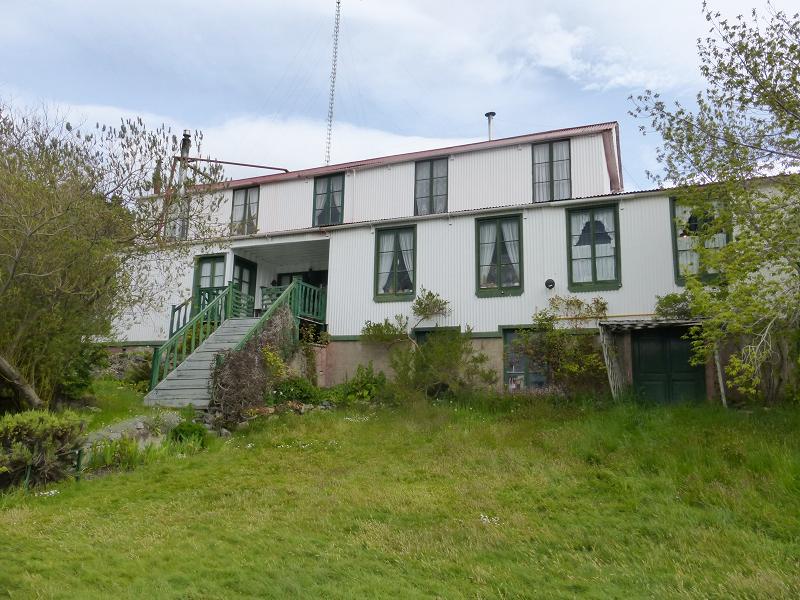
You will see from the pictures that the original house of 1887 is quite substantial. It has grown and been reduced as the family expanded (space was necessary for Will (third son of Thomas) and Despard’s (first son) families – Lucas (second son) didn’t marry until 1917 and lived elsewhere) and contracted as business requirements dictated. The climate at Harberton is wet and cold but, clearly Stephen Varder used top quality materials as, although the building is rustic, it has withstood the weather very well. The local wood is also hard and hardy – the farm is littered with dead trees which are barely rotted at all. Tommy told us that the wooded area across the bay was burnt in a forest fire in 1916 and the trees are still there with little evidence of decay. The trunks and branches just go to a silvery colour. It burns well and is used as the main form of house heating – and they certainly won’t run out!
The only evidence of arboreal destruction by an outside agency is that wrought by beavers! Introduced in the 1940s for their fur (possible by the military), they were either released when no longer needed or escaped. Their activities and sight of their lodges and dams is interesting, but an ecological problem, for which there seems little official interest in resolving.
The immediate farm area has the buildings and equipment which would be expected – wool sheds (record for the most sheep shorn by one man in a day: 255), cattle pens, sawmill and boats – the guest house was formerly a shepherd’s hut. But in the surrounding acres there are beautiful walks and views, both near and far across to Chile. Poignant too, with the family cemetery where Thomas’ son Will and his wife, Minnie May, are buried. She died in childbirth and he was heartbroken as she was his childhood sweetheart – daughter of the Lawrence family, second white family to settle away from Ushuaia about halfway between Harberton and the town. Apparently, he was so keen that he used to run most of the way between the two farms, with a brief overnight sleep in the forest, just to see Minnie May for the week-end!
Family group
Taken in the sitting room of the main house in the original part of the 1886/7 house. From left, Tommy Goodall, Liz Fearn, Natalie Goodall, Martin Fearn and Abby Goodall, their daughter who lives at Rio Grande, but manages the tourist side of the farm.
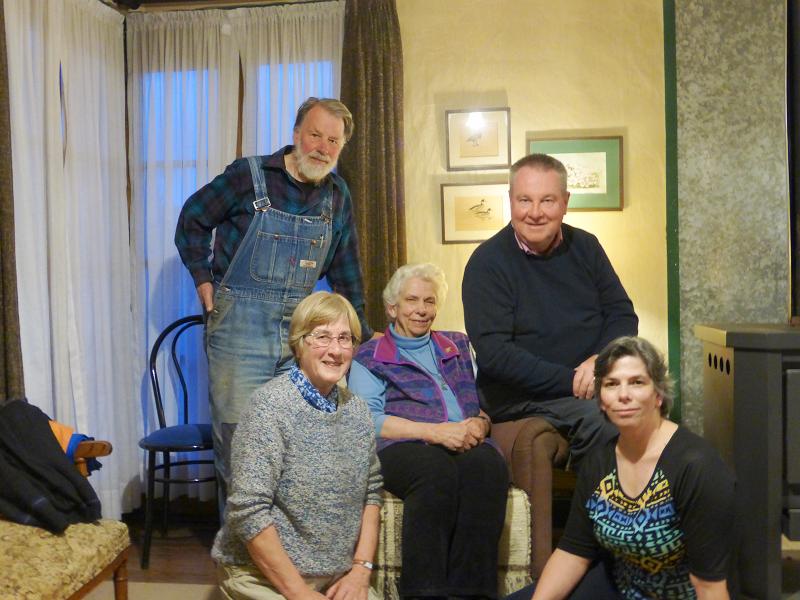
If you are interested in all this history, wait till we get home next year and come along to the talk the history society is planning. There will be pictures. Quite a lot! For now, suffice to say, we were made really welcome. Natalie invited us to eat with her and Tommy in their home each evening and on the second night Abby and Ricky were there too. Conversation was lively and often hilarious and covered everything from family stories, Tommy's flying exploits, education and Argentinian politics to the Scottish referendum! The next day, we also met Amalia, Natalie’s grand-daughter by her other daughter, Anne. Amalia was the rather grumpy, bored teenager who accompanied Natalie and Tommy on that visit to England in 2003, but is now a charming young woman who lives in Ushuaia and was there that day with her boyfriend, who just happens to be the boatman who runs the tours to Penguin Island. Oh yes, penguins! There will be pictures of penguins.
Penguins
This shot is of part of the colony of 6,000 pairs of Magellan penguins which breed on Martillo Island and then leave for the winter north of Tierra del Fuego and the Falklands. This island belongs to the Estancia and is about 10/15 minutes out in the Beagle Channel by fast motor boat. It is managed by a tour company and access limited to 80 people a day, but no more than 20 at any one time. The island also has a small – 30 or so Gentou or Papua penguins which breed here and remain year-round.

Natalie is (amongst other things) a renowned expert in the study of marine animals through their bones and her main interest now is the museum she has created for research and display in this area. She gave us a guided tour, both of the public display and of the behind the scenes area. The display is very graphic and sophisticated, with complete skeletons of all sorts of whales and dolphins suspended in front of life-sized paintings on the walls. We met some of her research students, who were busy putting together a jigsaw of whale bones – it certainly put my thousand piece puzzles into perspective!
In all we spent three days at Harberton and it was just right. We had seen everything and given poor Juani (yes, we were his friend by then) a sore throat with all the talking. If you stayed longer, you could go on more challenging treks into the hinterland, following the trail that Lucas made when he forged the way through to the north coast, but as you can imagine, that wasn’t really an option for us! We left on one of the buses that had brought a group for the penguin tour, courtesy of Andreas, Amalia’s boyfriend, and arrived back in Ushuaia one and a half hours later. It must have taken Tommy much longer when he built the 45km of road from the farm to meet the sealed national highway, Ruta 3, in 1963 – 4x4 in those days – the Jeep is still in the shed. The government didn’t adopt maintenance of the road until the late 1970s, but Tommy’s bit is still a dirt road.
We will never forget our visit to Estancia Harberton and we invited everyone we met to come and see the other one – as one of our guides put it “the real Harberton”. We told them they would get a great welcome – so if they ever do come, you know what you have to do!
Some of this will be repeated on our blog (Fearns at Large), but in much less detail, as we don’t expect non-Harberton friends to be so interested. If you want to follow our progress, you know where to find us, but for now, good-bye."